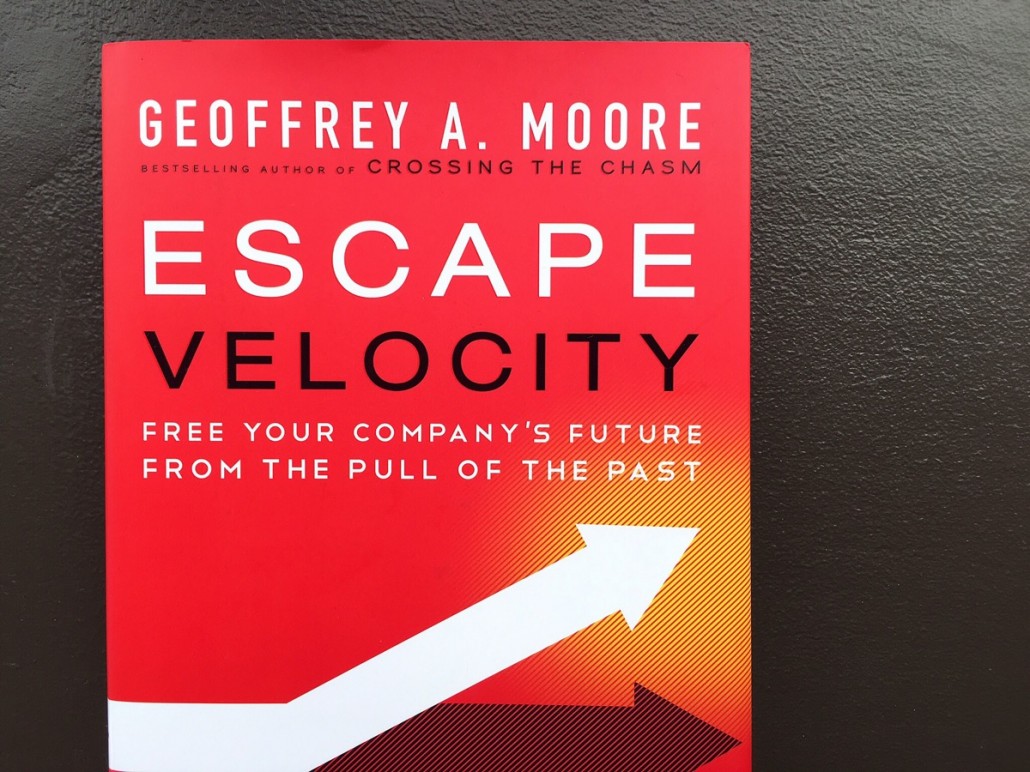
Recently, FirstRain had the opportunity to sponsor a dynamic event on leaving the competition behind, hosted by the Silicon Valley chapter of Strategic and Competitive Intelligence Professionals (SCIP).
SCIP has the mission to “be the premier advocate for the skilled use of intelligence to enhance business decision-making and organizational performance to create competitive advantage.”
This recent event included information on SCIP by the Silicon Valley chapter head, Alok Vasudeva, and a presentation on escaping velocity by Michael Eckhardt. Eckhardt, Managing Director & Senior Workshop Leader for Chasm Institute was also a contributing author to Geoffrey Moore’s book, Escape Velocity: Free Your Company’s Future from the Pull of the Past. You likely remember Geoffrey Moore’s name from his bestseller, Crossing the Chasm: Marketing and Selling Technology Projects to Mainstream Customers.
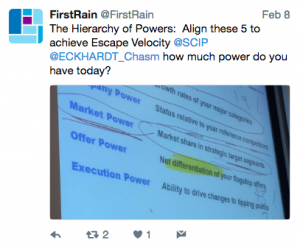
Appreciative of the opportunity to hear Eckhardt speak, we dove into note taking, live-tweeting the whole way. The Hierarchy of Powers outlines 5 ‘powers’ a company must align in order to escape velocity. We challenge you all to evaluate your own powers.
A convenient example, and no stranger to Moore, Apple once analyzed seems to have a solid 4 out of 5 powers in action.
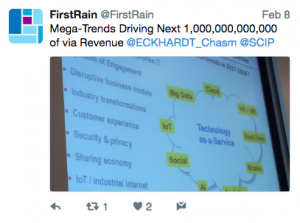
Because of our own industry focus, it was exciting for us to see the words “Analytics”, “Big Data”, and “Real-Time” in big letters as top revenue drivers. However, we’re still plenty excited about the trends outside our direct space that many of the attendees at the event are top leaders in. With the security and privacy market trending almost daily on every news forum from the national to the tech-specific, we’re looking forward to watching the major changes innovative companies will bring to the table.
After this event, we’re looking forward to finishing Escape Velocity and using it in customer conversations. We don’t want to give too much away but here’s a final teaser on the strategic wisdom strung throughout Moore’s pages,
“Leadership is about being in service to a higher cause; management is about ensuring that service is appropriately rewarded. Both are necessary. You just can’t put the focus on rewards first.” – Moore (p.13)
A big thank you to Alok Vasudeva for organizing, and for inviting FirstRain to participate in and sponsor, this engaging and enlightening Silicon Valley chapter event. We had a lovely evening and look forward to participating in future SCIP events.
If you are interested in learning more about how FirstRain can help you in your go-to-market strategies please contact Daniela Barbosa, our VP Marketing and Partnerships, to schedule a demo or to get more information.

Few things indicate an industrial revolution better than a controversial topic that ironically becomes a unifying factor. The biggest, boldest, headlines shout that 3 in 4 Americans are afraid to drive in an autonomous car, Uber and the DMV are head to head, and the autonomous car industry has the potential to eliminate jobs in up to 128 industries. However, other headlines have written a different story. From companies to technology to cars themselves, the Autonomous Car market is driving us all into a new, collaborative future.
Considered an initial stretch on the roadway to fully autonomous cars, V2V technology, vehicle-to-vehicle, is a wireless network enabling cars to converse with each other. At the next level, the technology would extend to V2I, vehicle-to-infrastructure, enabling cars and say, stoplights, to communicate as well. Consider a future city that is completely connected, from autonomous cars to smart buildings.
Collaboration is not just in the future. Even now, auto manufacturers and car service companies are establishing surprising relationships in order to win this grounded version of the “race to space”. Industry giant General Motors has reached out to carpool service application, Lyft, to test self-driving taxis. Alphabet, Google parent and Autonomous Car technology leader, may now be an Autonomous Car social leader as well in its car project, Waymo. The company already paired with Chrysler Pacifica minivans and is now in talks with Honda on accommodating Waymo’s self-driving technology in an upcoming model – a significant change from Google’s small, bubble cars I pass on our Bay Area roads. In a recent development, Audi and Nvidia have united over autonomous cars.
Those large companies seeking committed relationships, are resulting in start-up acquisitions at every turn:
Why do Autonomous Cars drive such cooperation? Maybe it is the cars’ origin – a unique world of technological cooperation. Founder of Comma.ai and iPhone unlocking, 26-year old George Hotz, has published open-source software and hardware driving agents in an effort to “become the Android of self-driving cars”. Consistent with this approach, Linux has devoted a foundation project to the mission of “creating open source software solutions for automotive applications.” The project, Automotive Grade Linux, or simply AGL, recently released the most advanced version of its platform yet. The AGL community is made up of nearly 90 companies with an impressive roster of Ford, Honda, Toyota, and more.
“This unprecedented level of collaboration is a clear indication that the automotive industry is adopting an open source development methodology that is resulting in faster innovation with more frequent software releases and new features.”
Dan Cauchy
Executive Director, Automotive Grade Linux
Maybe you’re not a fan of jumping on bandwagons. But with expectations of 21 million autonomous vehicles sold globally by 2035, it might be time for all of us to take a seat in any wagon pulled by the Autonomous Car.
This blog is part of an Industry & Market Series – analyzing what FirstRain users are tracking at the moment in order to gain advantage for the moment.

Finalizing your 2017 B2B Marketing strategy? Make sure you check in on what your B2C colleagues are doing too. In the annual “State of the Connected Customer” report for 2016 by Salesforce Research, surveyed marketers identified getting smart about personalization as a top requirement for meeting their marketing expectations in 2017.
Personalizing consumer messages has become the status quo for most B2C marketers. I have nearly a dozen emails sitting in my inbox, from this weekend alone, recommending cosmetics for my personal skin type and mobile apps for my personal habits. However, personalized messages aren’t just for B2C. Even for B2B, buyers increasingly voice that they want to be treated like humans, not numbers.
Forbes predicts that in 2017, B2B marketing focuses will include:
The two trends aren’t so separated. The answer to humanizing B2B messages with personalization can actually be found in those new data and analytic technologies. In the coming year, personalized experiences for business buyers will emanate from multiple channels including deployment of digital content, social interaction, and user communities.
The 2016 “State of Marketing” report by Salesforce Research shows over half of marketing leaders worldwide are set to increase spending on marketing tools and technology over the next couple years. The investments are driven directly by customer demand. For example,
Image: “State of the Connected Customer” Salesforce Research
For a tangible representation of this statistic, consider the possibilities of personalized, B2B marketing.
Targeted Messages and Target Markets
Your internal data reveals businesses are more likely to invest in your consulting services within a quarter of a new COO coming in. Using external data analysis of executive movements, you can deliver personalized messages to your target customers, automatically and effectively.
Engagement and Relationships
Your hospitality special events team is looking for opportunity indications around a prospect such as new industry conferences or changes in marketing spending. Events are automatically discovered, enabling your personalized messages to potential buyers that encourage your hospitality services over those of your competition.
With in-depth data and analytics becoming increasingly available, effective and personalized B2B marketing has become possible. It’s time to see your business buyers as more than just businesses.

You’ve heard about the recent cyber attacks. Everyone has. Now, everyone is questioning his or her own cyber security status. Take a look at today’s trending business Cyber Security terms, provided by FirstRain.
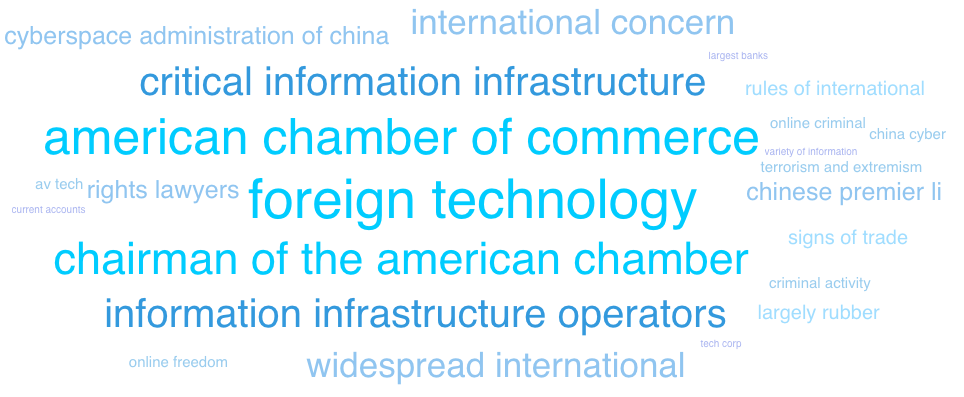
More than just an awareness opportunity, top companies are tackling major business opportunities in the industry, as indicated by FirstRain’s exploration map below. IBM’s recent news release announced that their security division is releasing a cyber security offering to protect banking customers. With finance being the main concern, Visa and Intel announced a collaboration agreement to create better payment security for connected devices, ranging from personal computers to wearable technologies. The companies assign the rising Cyber Security opportunities to the rise of the Internet of Things (IoT) market. Echoing this, Microsoft plans to release a security program for its own IoT service, Azure.
Other signs that the Cyber Security Industry is the hot market of the moment include the spike in acquisitions made by major corporations of cyber security companies. Recently, Samsung Electronics announced it will be acquiring start-up enterprise software company, Tachyon Mobility to “build up their cyber security businesses with acquisitions.”
With Cyber Security heating up, this might lead to the security breakthrough, so to speak, that we need. Author and CIO, Tim Elkins states that “security isn’t an IT problem; it’s a business problem.” If so, IT might just start to receive the attention, budget, and opportunity to transform the industry. However, regardless if you are a vendor or a buyer, in tech or retail, following movements in Cyber Security is essential to business success. In other words, always be prepared because it just makes good sense.
This blog is part of an Industry & Market Series – analyzing what FirstRain users are tracking at the moment in order to gain advantage for the moment.

Sometimes it seems that executives change positions faster than your morning coffee can brew. However, even when executive changes affect your business directly, you might be the last to know.
It can be overwhelming, keeping track of the perpetually changing status for management in your companies of interest – customers, partners, or competitors. Often we are forced to just rely on the traditional online professional networking platforms like LinkedIn, for professional updates.
Unfortunately, LinkedIn is dependent on user inputs for updates, and much of its value as a business intelligence tool is stunted by a trend involving executive level professionals neglecting their LinkedIn presence.
How Professionals are Using LinkedIn
LinkedIn is meant to encourage connections, learning, and sharing. Users of LinkedIn build a professional identity online, a concept inspired by traditional paper resumes, to build networks with colleagues and classmates while maintaining a presence in the job market.
For Market Research
In addition to its most famous uses as a job-search tool and professional social network, LinkedIn claims you can find “the latest news, inspiration, and insights you need to be great at what you do.”
Motivated by the claim, LinkedIn users have been applying the network to marketing and sales research. A solid 41% of B2B marketers consider LinkedIn their default social platform, as indicated in a 2015 Social Media Marketing industry report.
For Building Brand Awareness
It’s true that LinkedIn is brimming with information. Companies eagerly post content, hoping to hop on the social marketing wagon and build brand awareness. You can cultivate this awareness with LinkedIn when you have a well-maintained company page, augmented with equally well-maintained executive profiles. However, LinkedIn tends to be biased since a company’s own social media experts curate and manage company-specific information.
When Executives Don’t Give LinkedIn What it Needs to Succeed
Although executive profiles are a positive tool for brand cultivation on LinkedIn, many C-level employees do not maintain their profiles, if they have one at all. A creator of multiple start-ups, Shaun McConnon, publicly boasts about not being on LinkedIn. Those top executives who do have LinkedIn often neglect this presence to the extent of violating the main rule for LinkedIn success: always keep your profile updated.
According to recruiter Andrew Johnson, not maintaining your LinkedIn profile could be for a number of reasons, including:
Here at FirstRain, we noticed a rising trend in executive-level employees neglecting or forgoing LinkedIn profiles. If you follow us on Twitter, you have seen some examples of Management Changes across various industries:
Event detected 8/23/16 and tweeted on 8/30/16
Since LinkedIn updates originate from the users themselves, this trend of slow to non-existent updating throws a major wrench into the network’s use as a timely and useful research tool to understand management turnover.
Event detected on 8/5/16 and tweeted on 8/10/16
To see more of our management turnover updates, head over to our Twitter page.
How Does this Affect You?
If you are relying on LinkedIn alone, you might be missing top-level changes in companies of interest. Such changes often indicate a shift in direction in terms of company control, power, culture, or even a combination.
In sales or account management, an executive change can act as a catalyst for relationship development. Management changes can cause previously out-of-reach companies to become more hospitable or better aligned with your product or service. On the other side, if a change stems from a negative cause, think layoffs or poor leadership, you may consider the change a reason to contact your account.
At the end of the day, meaningful and valuable business relationships are possible only when you know your accounts intimately and executive level changes are a key part of this.
Don’t Jump Ship, Just Grab Another Oar
LinkedIn isn’t sinking and there’s no reason to jump. Instead, simply supplement the network with a tailored research tool. FirstRain presents key insights on your customer, competitors, and industries of interest in a streamlined manner so you receive the updates you rely on without the noise. Unlike other business analytics engines, FirstRain incorporates the business web and social media content for a one-stop shop of business intelligence.
Management changes are highlighted in at-a-glance panels and cover management and executive hires, departures or internal moves within a company, and board changes. Management Change analytics include senior level hires and retirements, executive promotions and resignations, and even plans for departure. To easily consume these key insights, the changes are presented for a specific company, account, industry, or topic of interest and can be further filtered down by your choosing.
Events detected 8/10-18 on and tweeted on 8/18/16
Where LinkedIn is lacking, there’s FirstRain to help.
Want to see just how FirstRain fits into your day? Here’s a video for those of you in sales. For those of you in marketing, read this overview.
Have thoughts you want to share or questions you need to ask? We’d love to hear from you.

This is part of the FirstRain Persona Series.
Customers are demanding more of a digital experience, and the rise of a Chief Digital Officer (CDO) has soared to fulfill the need. Providing customers with the most valuable digital experience is a CDO’s primary objective.
In the past, executives with digital oversight roles concentrated on magnifying a company’s online presence and brand. Today, however, the role of a Chief Digital Officer is truly focused on the customer experience.
The fact of the matter is that buyers are no longer making purchasing decisions, or accessing portals solely from a desktop computer, but rather via mobile platforms, emails, and social media —on the go. Thus, CDO’s are challenged with meeting the demands of a fast-paced consumer society that is always moving.
Customers access platforms and consume vast amounts of product information via different touch points: cell phones, tablets, emails, internal enterprise platforms, LinkedIn, Facebook, Twitter, Instagram, the web, video streams, vines, Periscope, etc. Today’s digital market demands seamless execution from all these platforms and CDO’s are leading that charge.
Coupled with a strong, robust digital strategy a CDO facilitates the customer experience, but how can that help grow your business?
A deep understanding of market trends and consumer behavior must be leveraged across all customer touch points; from small marketing campaigns, to large scale product launches. This often involves leaders in business development, and becomes fundamental to helping a business evolve in today’s marketplace.
A recent McKinsey article on “The Transformer in Chief” stresses, “It’s up to the CDO to identify those functions where digital is critical: for example, investing in automation capabilities to rapidly respond to customer interactions, developing sophisticated reporting and analytics capabilities to interpret customer needs, building innovative interfaces to gather customer data (for example, an alternative payment method), and creating mechanisms to deliver content and offers across all relevant channels.”
Chief Digital Officers must identify the customer facing journey, drive customer engagement, and make sure that the dashboard touch points that she decides to implement for her company responds to market demands in real time. They are responsible for putting the tools in place to interpret customer insights with a main strategic goal of responding to customer engagement needs.
Customer intelligence tools such as FirstRain, helps interpret customer behavior via market trends, industry changes, and social media. Target market analysis of what is trending in relationship to business goals and objectives are crucial for driving a business forward. After all, the customer is always right, right?
Fundamentally understanding customer needs and how they intersect with revenue goals can make or break a digital strategy, making the role of a Chief Digital Officer pivotal for any industry. A CDO must demonstrate agility to respond and adapt quickly to customer demands/needs, and are often faced with making bold decisions.
Wired.com asserts, “The CDO will drive the digital functional excellence from strategy to infrastructure and ensure that we have the right competence and capabilities to support and leverage the business from a digital perspective.”
CDO’s are not only the liaison between customer and product but become key partners with CIOs, CMOs, Sales Officers and CFOs. They communicate the intricacies of market trends, new technology developments and customer behavior to create a digital strategy that is mindful of all these shifting plates, with the end goal to meet revenue objectives.
In today’s hyperactive commerce market, a strong digital strategy is necessary. If done successfully, a CDO can move their company’s business platform to not only meet the demands of the customer, but also revenue goals of the enterprise.
For further reading from our C-Suite buyer persona series:

It’s a new year and everyone is looking for digital trends that will optimize business strategy this year. We trust that things are already in full swing your business initiatives and we want to recap on our favorites brought to you from our friends at Altimeter.
CEO, Charlene Li, thinks, “Agile customization of experiences becomes a priority” in 2016, and we could not agree more.
Industry Analyst, Ed Terpening, acknowledges a rising complexity in the digital ecosystem.
Today’s business world is not static and your digital strategies must address not only volume of data but recency based on the specific role and need of the ‘consumer’ of that data. That is why our FirstRain Business Web Graph continually scans the structure of the living Web and the topics, triggers and business lines continually change over time, evolving and expanding based on system input and customer feedback.
FirstRain is an enterprise leader in providing a competitive analysis of target market analysis that will help optimize your business strategy this year.
Feel free to contact us for a free demo, and show you how actionable insights can empower your digital strategy this year.

This is part of the FirstRain Persona Series.
Many may not recognize the title, “Chief Strategy Officer,” as part of the C-Suite, as the role has recently become popular, but will recognize a CSO’s duties. People have come to know the CSO as the “enforcer”, or a “mini-CEO” because of their main focus: to implement the vision of the CEO and company.
No one likes to be the “tough guy”, but many companies have already recognized a need for a Chief Strategy Officer such as Deloitte, IBM, Citrix, Intuit, Cloudera, Oracle and Cisco. CSO’s are usually recruited from veteran roles in management where they have a proven track record of successfully leading teams. Often their titles are coupled with CTO, Head of Corporate Development, and VP of Strategic Alliances.
Today, the CSO works closely with the CEO and bears the challenge of rapidly implementing a strategy that will drive a company to meet end goals and objectives. They understand the importance of being able to influence and mentor people to meet industry demands.
So what does the chief strategy officer do? Some CSO’s act more like a strategist while others are “doers”, and others, facilitators, but regardless of their implementation style, they must effectively oversee the entire company’s strategic plan.
A top priority for a CSO is bringing cohesiveness across the company and making sure that everyone is on board with the company’s strategic goals. Not everyone is apt for change, but working together is necessary to effectively move a company forward. A lot of a CSO’s time is spent working closely with upper management to communicate clearly the next stages a company must make. Their message must be clear-cut and definitive to create an immediate response from these teams.
Setting concrete plans, and goals are necessary to meet long-term visions. With a dynamic list of priorities, a CSO must be mindful of change. In today’s hyperactive digital business world, strategies must account for market changes. Successful CSO’s are not reacting to market trends and changes, they are preparing for them.
Acting pre-emptively to threats, competitors and all the other bumps on the road, will be key to the success of the office of the CSO. Today’s CSO must leverage business intelligence tools that are responsive to market trends and changes and, therefore, able to focus on facilitating strategy as the company’s “Strategy Orchestrator”.
For example in the financial industry, a CSO might be responsible for mitigating risk and growth opportunities. They must be aware of mergers and acquisitions, competitors, global economic changes and especially disrupting technologies in FinTech. This can be overwhelming and can deter a CSO away from enabling a strategic plan. Enterprise business intelligence platforms are fulfilling the need of identifying risk within markets. Companies like FirstRain identify market trends and provide their users with actionable insights to better prepare for market changes, competitors and opportunities.
In Industrial Manufacturing, for example, a CEO’s plan might require rapid growth to stay afloat, and this will require a Chief Strategy Officer to work closely with Sales and Marketing to implement a strategy that will require sales teams to work more effectively. For a sales team to drive results, they must be supplied with technology that prioritizes clients and presents actionable insights for new opportunities that help fulfill the corporate strategy. CRM intelligence software helps prioritize tasks that meet short-term goals, mid-term goals, and successfully steers a company to growth.
Regardless of the industry, a Chief Strategy Officer plays a key role as a leader who understands the mechanics of getting things done. The role often demands the CSO to drive a company through market change, growth, or disruptions, but at end of the day, the CSO must be influential in facilitating change and bringing a vision to live.
To read additional posts on FirstRain buyer Personas:
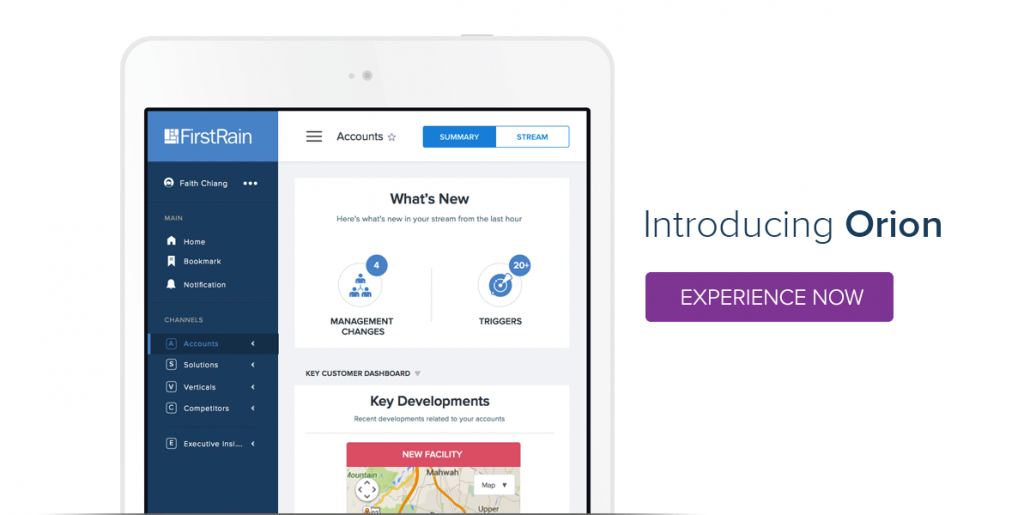
The wait is over. The FirstRain Orion release is causing quite an impactful stir in the world of technology. Orion, released on June 17th, is the world’s first analytics platform that brings together external and internal unstructured data to coach teams and professionals on key business developments that affect their go-to marketing strategy, business relationships, and investments.
Recognition for this universal architecture is coming from every angle, including senior executives from Racepoint and top 10 global pharma company who highlight “smooth integrations” and “increased productivity” driven by FirstRain solutions. The primary topics of discussion displayed Orion’s ability to elevate the delivery of information by:
“We are delighted to bring the new FirstRain Orion architecture to our Fortune 1000 enterprise customers,” said Penny Herscher, FirstRain president and CEO. “The seamless integration of critical and personalized customer and market insights into their enterprise-wide solutions and mobile-first initiatives will help them grow revenue by dramatically improving the speed and quality of the employee’s daily business decisions.”
Review some of the articles covering the FirstRain Orion:
New analytics platform from FirstRain
FirstRain Extends Analytics Reach to include Internal Data Sources
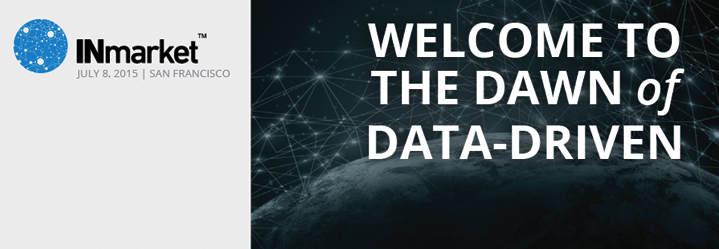
The dawn of data-driven is here. Gone are the days of getting excited about backwards-looking analytics and reporting. Join us at INmarket on July 8th, in San Francisco to explore how data and AI are driving billions of dollars of revenue for B2B marketing and sales. Predictive intelligence will impact all industries, businesses, and our daily lives in ways we can only begin to imagine.
Speakers include senior executives from Cisco, Forrester, LinkedIn, Salesforce.com, MongoDB, CSC, NetSuite, Lenovo and many more. The agenda will include topics such as:
As a partner of 6sense, we’re happy to share a 25% off discount code with you (plus all registrations go to . Use code FIRSTRAIN when you register and we will see you there!
